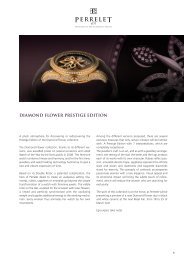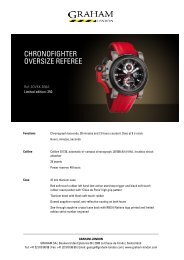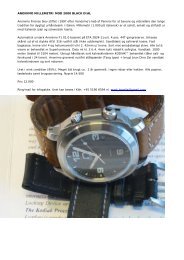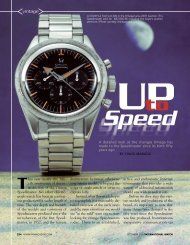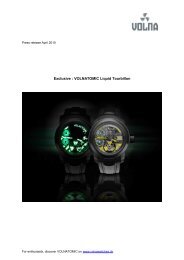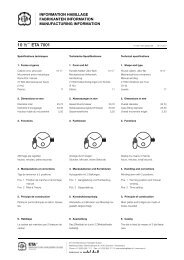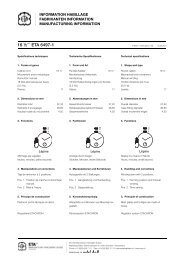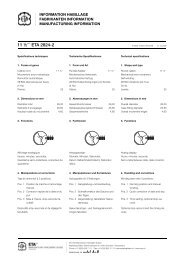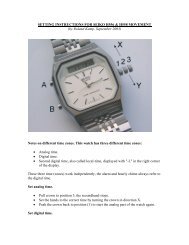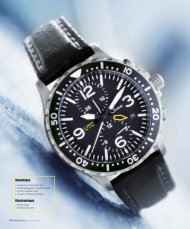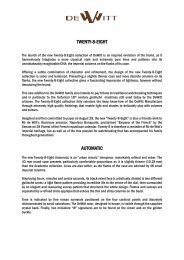SA.45s CSAC - Watchuseek, World's Most Visited Watch Forum Site
SA.45s CSAC - Watchuseek, World's Most Visited Watch Forum Site
SA.45s CSAC - Watchuseek, World's Most Visited Watch Forum Site
You also want an ePaper? Increase the reach of your titles
YUMPU automatically turns print PDFs into web optimized ePapers that Google loves.
<strong>SA.45s</strong> <strong>CSAC</strong><br />
Chip Scale Atomic Clock<br />
KEY FEATURES<br />
• Power Consumption
LOW POWER CONSUMPTION BY DESIGN<br />
Every part of the <strong>SA.45s</strong> <strong>CSAC</strong> has been engineered for low<br />
power consumption. It starts with the physics package, shown<br />
here in a cutaway view. A vertical-cavity surface-emitting laser<br />
(VCSEL) that has been highly optimized for this specific<br />
application illuminates the atomic vapor resonance cell, and<br />
the light that gets through the cell is then detected by the<br />
photodetector. The photodetector output signal drives a<br />
feedback loop which is used to achieve atomic resonance<br />
using the principles of coherent population trapping (CPT).<br />
The entire physics package has a volume of only 0.35 cm3 ,<br />
and the actual resonance cell itself has a volume of only 2<br />
mm3 . It is this extremely small size, plus the fact that it is<br />
surrounded by a vacuum within the physics package, that<br />
allows the entire physics package to be powered by only 10<br />
mW. As the cutaway drawing shows, the only way the physics<br />
package connects with the outside world is through a<br />
suspension of polyimide strips. All signals that need to go to<br />
or from the center stack-up are carried on traces that are<br />
printed on the polyimide strips. And because the strips are<br />
connected to a frame that is engineered to be slightly shorter<br />
than the center stack-up, the strips are in tension and serve<br />
to hold the stack-up in place. The result is a very small, highly<br />
thermally isolated, and robust physics package with excellent<br />
performance. All of the electronics that surround the physics<br />
package package, and which turn it into a fully functional<br />
clock, have also have also been engineered for low power<br />
consumption. Even the <strong>CSAC</strong> controller’s firmware routines<br />
have been optimized for low power consumption.<br />
LOW POWER IS JUST THE BEGINNING<br />
An atomic clock that consumes only 115 mW of power (125<br />
mw for option 002) instead of 10 W or more gives system<br />
designers a new and important degree of freedom. But that is<br />
just the beginning. Because of its small size and high thermal<br />
isolation, the <strong>SA.45s</strong> <strong>CSAC</strong> warms up in
UNDERWATER SENSOR SYSTEMS<br />
Underwater sensors are used in seismic research, oil<br />
exploration and many other applications. Sensors designed to<br />
lie on the ocean floor will typically include a hydrophone, a<br />
geophone and a very stable clock to time-stamp the data<br />
collected by the sensor. Because GPS signals can’t penetrate<br />
water, oven-controlled crystal oscillators (OCXO’s) have been<br />
used to provide the accuracy needed for most time-stamping<br />
applications.<br />
But the <strong>SA.45s</strong> <strong>CSAC</strong> is a nearly<br />
ideal clock for these underwater<br />
applications. Because it consumes<br />
1/10 th to 1/30 th the power of an<br />
OCXO, it requires much less<br />
battery power, resulting in smaller<br />
and lower-cost sensors, or<br />
alternatively, sensors with a much<br />
longer mission life.<br />
The <strong>SA.45s</strong> <strong>CSAC</strong>’s aging rate, which can be 1/100 th of even a<br />
good OCXO, means that time-stamping errors caused by drift<br />
are greatly reduced. Finally, the <strong>SA.45s</strong> <strong>CSAC</strong>’s superior<br />
temperature coefficient means that when sensors are<br />
calibrated to GPS on a warm boat deck, but then dropped into<br />
cold ocean water of several hundred meters depth, the offset<br />
error produced by this temperature change is minimized.<br />
PORTABLE MILITARY SYSTEMS<br />
Many advancements in military electronics are aimed at<br />
bringing the networked battlefield to the tactical edge, i.e. the<br />
individual warfighter. But there are limitations on how many<br />
pieces of gear and how much battery weight a warfighter can<br />
be expected to carry. This is especially true when operations<br />
are carried out in rugged terrain and/or high altitude. The<br />
<strong>CSAC</strong>’s small size, light weight, and extremely low power<br />
consumption can help in a number of systems:<br />
IED Backpack Jammers: size and weight are always at a<br />
premium, so the <strong>SA.45s</strong> <strong>CSAC</strong> is an attractive option. Also,<br />
power not applied to the timing subsystem is power that can<br />
be applied to the jammer itself, or that can be used to extend<br />
Sound Pulse<br />
Ocean floor<br />
30m to 2000 m depth<br />
Regularly spaced<br />
hydrophones or geophones<br />
For underwater sensor applications requiring even less power<br />
consumption, the <strong>SA.45s</strong> <strong>CSAC</strong>’s ultra-low power mode allows<br />
the user to turn off the unit’s physics package and let the<br />
<strong>SA.45s</strong> <strong>CSAC</strong> operate as a free-running TCXO. The physics<br />
package is then periodically turned back on to re-discipline<br />
the TCXO. This can result in very low power consumption<br />
(
UNMANNED AERIAL VEHICLES<br />
As the number of applications for civil and military umanned<br />
aerial vehicles (UAVs) rapidly expands, the suppliers of payloads<br />
for these vehicles are being pressured to increase their<br />
functionality. In doing so, they find themselves bumping into<br />
limitations in size, weight and power.<br />
4<br />
The <strong>SA.45s</strong> <strong>CSAC</strong> can help in all<br />
three areas, with a volume of
<strong>SA.45s</strong> <strong>CSAC</strong><br />
Specifications<br />
All specifications at 25°C, 3.3VDC unless otherwise specified<br />
ELECTRICAL SPECIFICATIONS<br />
-001 -002<br />
RF Output<br />
- Frequency: 10 MHz 10 MHz<br />
- Format CMOS CMOS<br />
- Amplitude: 0-3.3 V 0-3.3 V<br />
- Load Impedance 1 MΩ 1 MΩ<br />
- Quantity: 1 1<br />
1 PPS Output<br />
- Rise Time: < 5 ns < 5 ns<br />
- Pulse Width: 400 µs 400 µs<br />
- Level: 0-3.3 V 0-3.3 V<br />
- Load Impedance 1 MΩ 1 MΩ<br />
- Quantity: 1 1<br />
1 PPS Input<br />
- Format: Rising edge Rising edge<br />
- Low Level: < 0.5 V < 0.5 V<br />
- High Level > 2.5 V > 2.5 V<br />
- Input Impedance: 1 MΩ 1 MΩ<br />
- Quantity: 1 1<br />
Serial Communications<br />
- Protocol: RS232 RS232<br />
- Format: CMOS 0-3.3 V CMOS 0-3.3 V<br />
- Tx/Rx Impedance: 1 MΩ 1 MΩ<br />
- Baud Rate 57600 57600<br />
Built-in Test Equipment (BITE) output<br />
- Format: CMOS 0-3.3 V CMOS 0-3.3 V<br />
- Load Impedance: 1 MΩ 1 MΩ<br />
- Logic: 0 = Normal operation<br />
1 = Alarm<br />
Power Input<br />
- Total Power: < 115 mW < 125 mW<br />
- Input Voltage: 3.3 ± 0.1 VDC 3.3 ± 0.1 VDC<br />
- Current: < 35 mA < 38 mA<br />
PHYSICAL SPECIFICATIONS<br />
- Size: 1.6” x 1.39” x 0.45” 1.6” x 1.39” x 0.45”<br />
- Weight: < 35 g < 35 g<br />
- MTBF: > 100,000 hours > 50,000 hours<br />
ENVIRONMENTAL SPECIFICATIONS<br />
Operating:<br />
- Operating Temperature:<br />
- Frequency Change Over<br />
-10 °C to +70 °C -40 °C to +85 °C<br />
Operating Temp Range: ±5x10-10 ±1x10-9 - Frequency Change Over<br />
Allowable Input<br />
Voltage Range: < 3x10-10 < 3x10-10 - Magnetic Sensitivity:<br />
(± 0.5 Gauss): < 4x10-10 /Gauss < 4x10-10 /Gauss<br />
- Radiated Emissions. Compliant to FCC Compliant to FCC<br />
part 15, Class B, part 15, Class B,<br />
when mounted in when mounted in<br />
PCB. PCB.<br />
ENVIRONMENTAL SPECIFICATIONS<br />
- Vibration: Maintains lock under Maintains lock under<br />
MIL-STD-810, MIL-STD-810,<br />
method 514.5, method 514.5,<br />
Procedure 1, 7.7 grms Procedure 1, 7.7 grms<br />
- Humidity 0 to 95% RH per 0 to 95% RH per<br />
MIL-STD-810, MIL-STD-810,<br />
Method 507.4. Method 507.4.<br />
Storage and Transport (non-operating):<br />
- Temperature: - 55 °C to +90 °C - 55 °C to +90 °C<br />
- Shock (1 ms half-sine): 500 g 500 g<br />
- Vibration: Maintains lock under Maintains lock under<br />
MIL-STD-810, MIL-STD-810,<br />
method 514.5, method 514.5,<br />
Procedure 1, 7.7 grms Procedure 1, 7.7 grms<br />
PERFORMANCE PARAMETERS<br />
-001 -002<br />
Stability (Allan Deviation)<br />
ADEV ADEV<br />
TAU = 1 sec 2 x 10-10 3 x 10-10 TAU = 10 sec 7 x 10-11 1 x 10-10 TAU = 100 sec 2 x 10-11 3 x 10-11 TAU = 1000 sec 7 x 10-12 1 x 10 -11<br />
RF Output Phase Noise (SSB)<br />
1 Hz < -53 dBc/Hz < -53 dBc/Hz<br />
10 Hz < -75 dBc/Hz < -75 dBc/Hz<br />
100 Hz < -115 dBc/Hz < -115 dBc/Hz<br />
1000 Hz < -128 dBc/Hz < -128 dBc/Hz<br />
10000 Hz < -134 dBc/Hz < -134 dBc/Hz<br />
100,000 Hz < -140 dBc/Hz < -140 dBc/Hz<br />
Frequency Accuracy<br />
- Calibration at shipment: ± 5x10 -11 ± 5x10 -11<br />
- Retrace (48 hrs off): ± 5x10 -11 ± 5x10 -11<br />
- Aging:
SYMMETRICOM, INC.<br />
2300 Orchard Parkway<br />
San Jose, California<br />
95131-1017<br />
tel: 408.433.0910<br />
fax: 408.428.7896<br />
info@symmetricom.com<br />
www.symmetricom.com<br />
©2010 Symmetricom. Symmetricom and the Symmetricom logo are registered trademarks of Symmetricom, Inc. All specifications subject to<br />
change without notice. DS/<strong>SA.45s</strong> <strong>CSAC</strong>/123010/PDF




